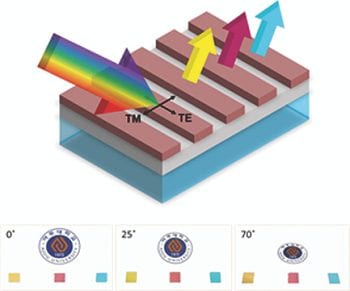Color filters are regarded as an essential component in diverse areas, including colored display systems and image sensors. Traditional color filters utilize organic dyes or chemical pigments, which can produce colors by absorbing a certain band of visible light. However, in nature, colors can be also produced by light, which interacts with physical structures (e.g. blue color of the Morpho butterflies having photonic crystal-like volume-diffractive nanostructures on its wings). Inspired by these natural phenomena, various structural color filters have been developed due to their intriguing characteristics such as slim dimension, high efficiency, great durability, and low power consumption. All provide distinct advantages over traditional color filters.
 However, filtering incident light for any direction to achieve a wide angle view, without a change of the desired colors, remains largely challenging. Most of the structural color filters have utilized this mechanism, inducing color change according to the incident angle, to create the desired colors. Even though simple ultra-thin optical nanocavity-based color filters without nanostructures have been developed to address this angle sensitivity issue, their thicknesses should be adjusted to control the color. This requires three separate lithographic processes to prepare a pixel unit, composed of RGB or CMY. Researchers have now introduced an angle-insensitive structural color filtering scheme based on strong interference effects in ultra-thin subwavelength semiconductor gratings on metallic substrates. The proposed color filter devices, which are fabricated over a large area using nanoimprint lithography, produce distinctive reflection colors that are easily tuned by altering a width of the nanostructured gratings even with the fixed thickness of the structure. Thus allowing all the individual color pixels to be patterned via a one-step fabrication process. Moreover, all the materials utilized in this structure are CMOS-compatible.
However, filtering incident light for any direction to achieve a wide angle view, without a change of the desired colors, remains largely challenging. Most of the structural color filters have utilized this mechanism, inducing color change according to the incident angle, to create the desired colors. Even though simple ultra-thin optical nanocavity-based color filters without nanostructures have been developed to address this angle sensitivity issue, their thicknesses should be adjusted to control the color. This requires three separate lithographic processes to prepare a pixel unit, composed of RGB or CMY. Researchers have now introduced an angle-insensitive structural color filtering scheme based on strong interference effects in ultra-thin subwavelength semiconductor gratings on metallic substrates. The proposed color filter devices, which are fabricated over a large area using nanoimprint lithography, produce distinctive reflection colors that are easily tuned by altering a width of the nanostructured gratings even with the fixed thickness of the structure. Thus allowing all the individual color pixels to be patterned via a one-step fabrication process. Moreover, all the materials utilized in this structure are CMOS-compatible.
The strategy presented could offer new avenues for diverse applications, including imaging sensors, LEDs, sensing, anti-counterfeit tag and color e-paper technologies.

















